Unit 4 Humour Lesson 1 What’s So Funny? Reading课件(共43张PPT,内镶嵌视频)北师大版(2019)选择性必修第二册
文档属性
| 名称 | Unit 4 Humour Lesson 1 What’s So Funny? Reading课件(共43张PPT,内镶嵌视频)北师大版(2019)选择性必修第二册 | 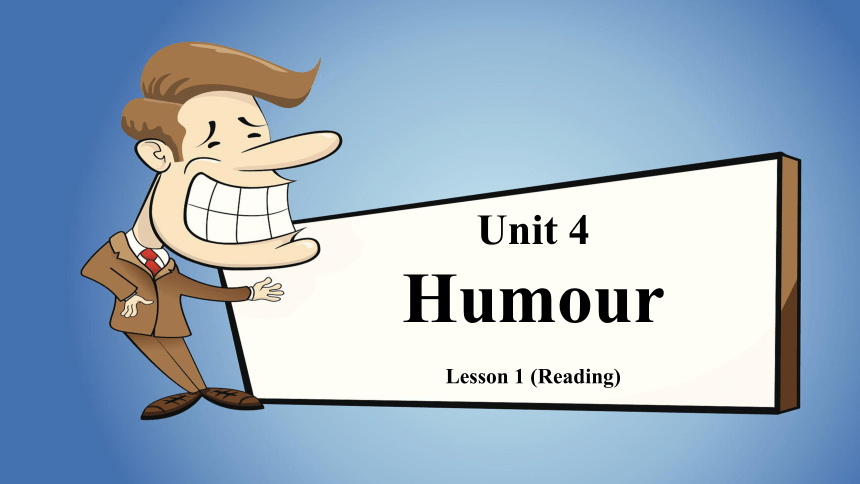 | |
| 格式 | pptx | ||
| 文件大小 | 31.7MB | ||
| 资源类型 | 教案 | ||
| 版本资源 | 北师大版(2019) | ||
| 科目 | 英语 | ||
| 更新时间 | 2025-08-01 11:03:53 | ||
图片预览

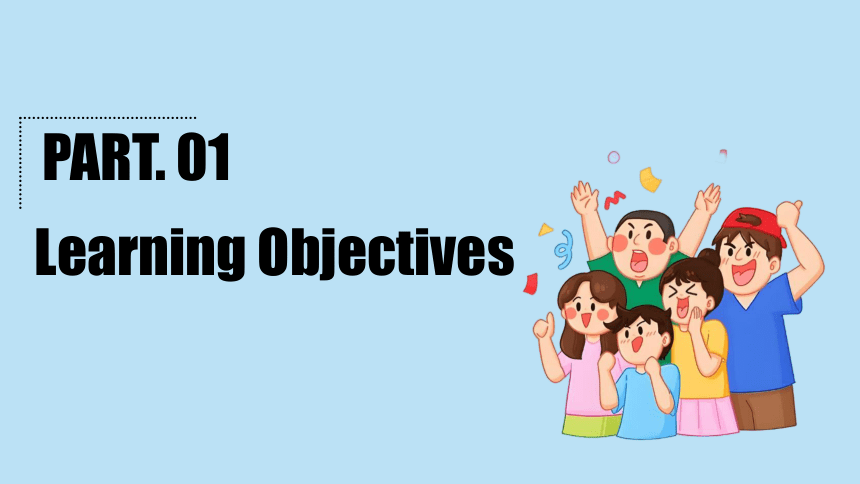
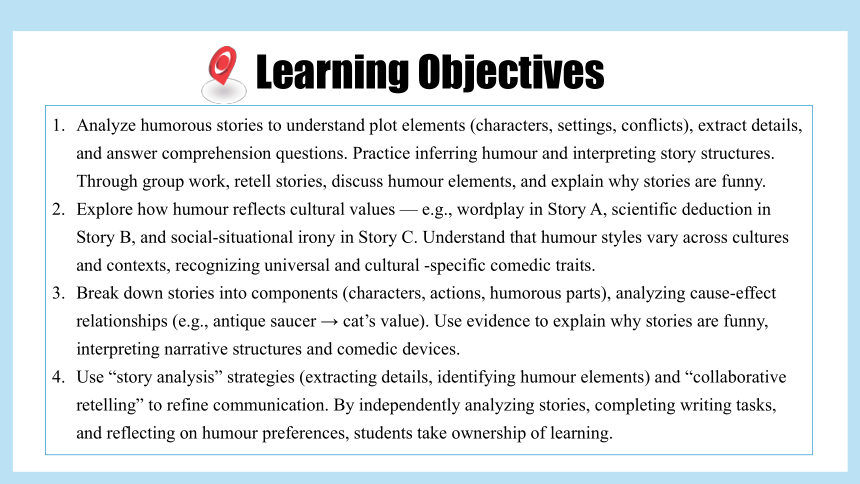
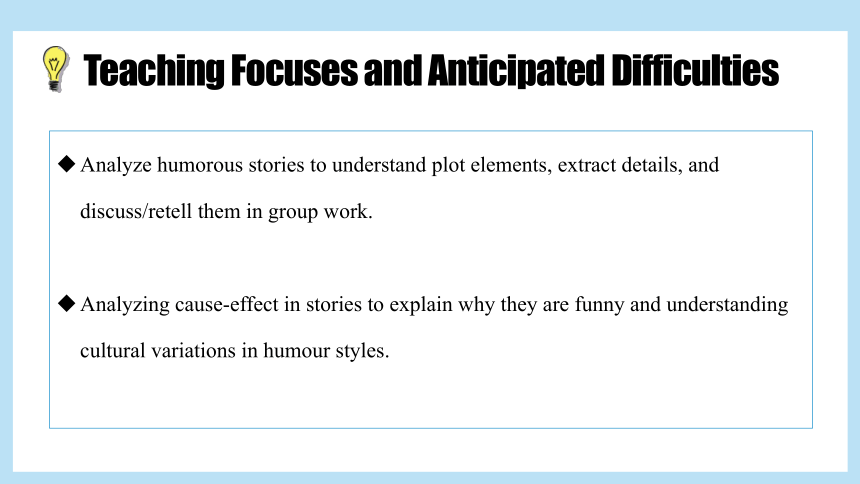

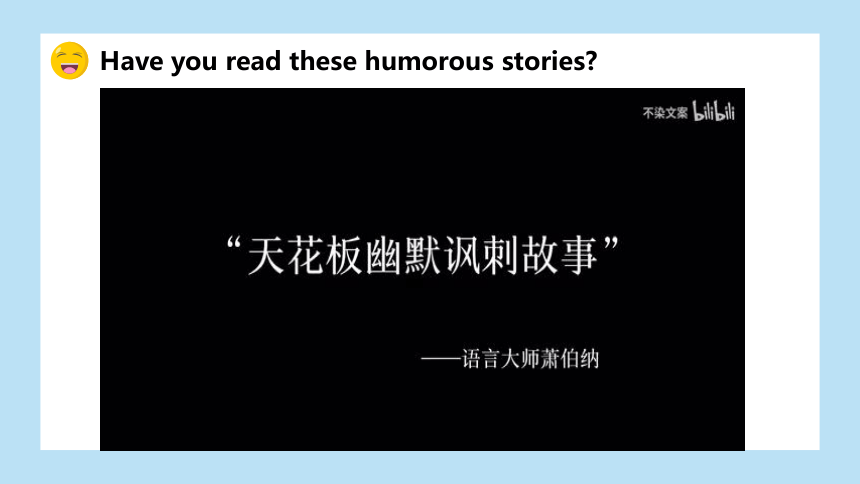
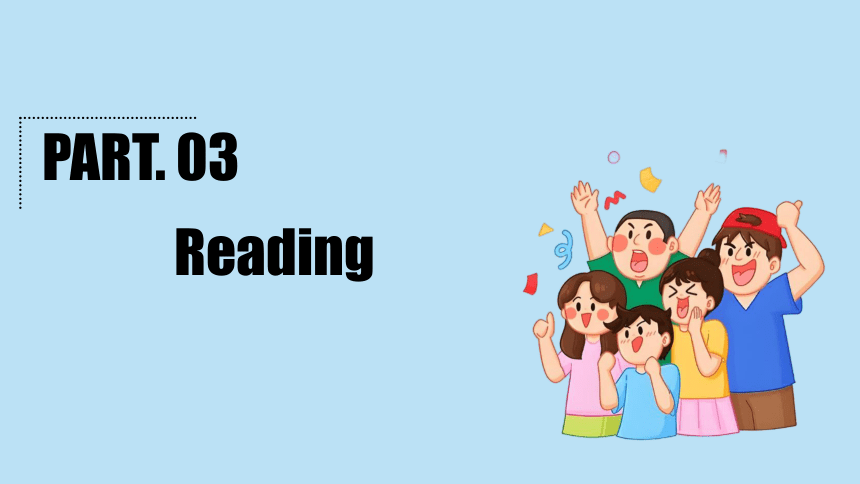
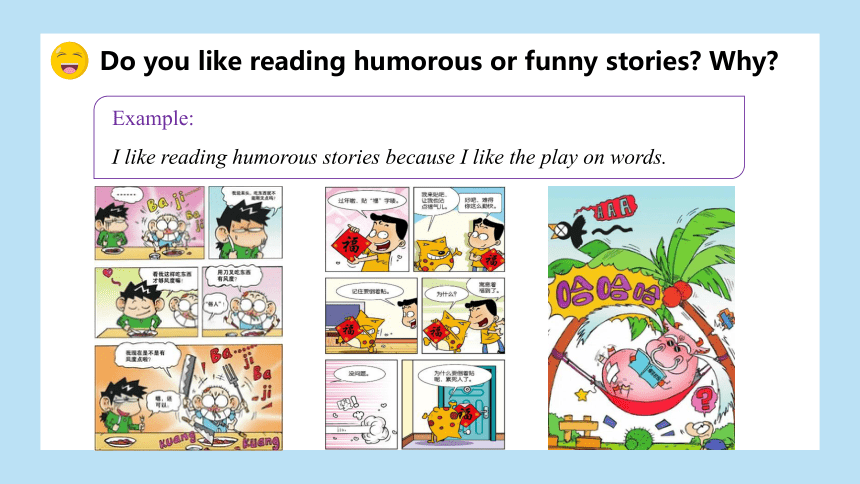
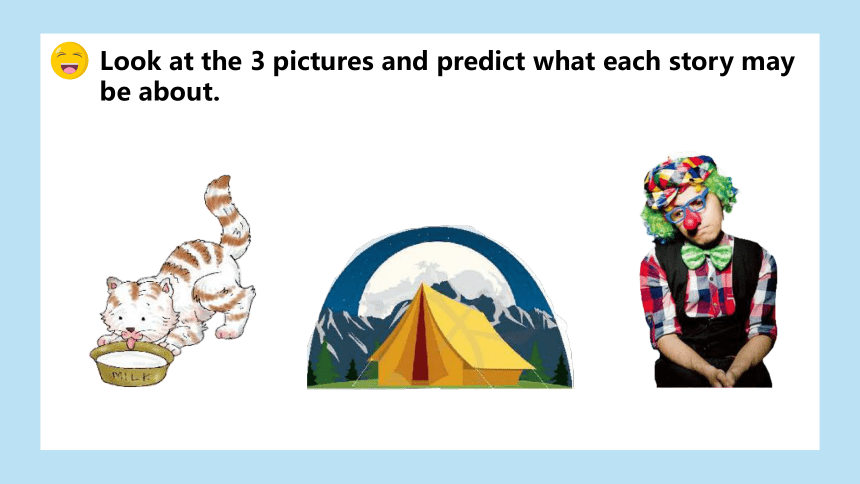
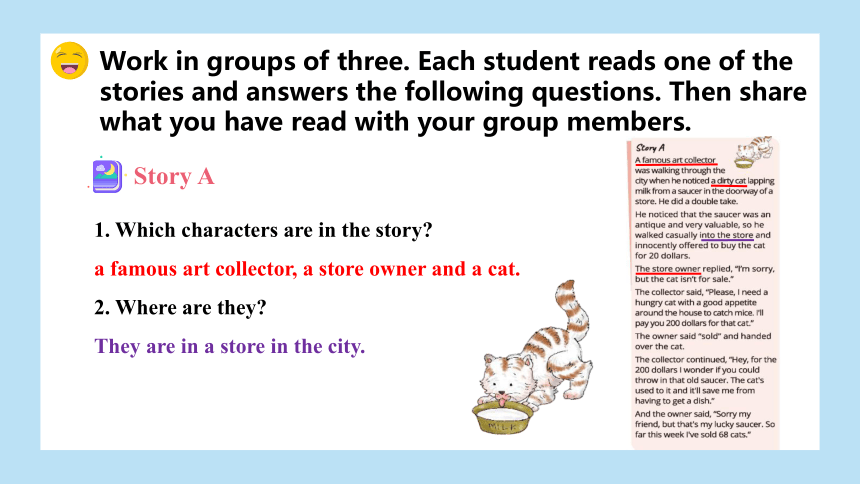
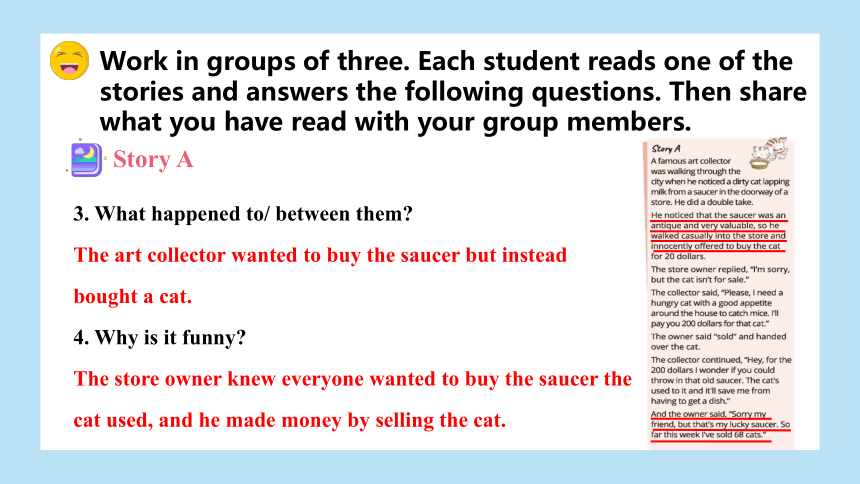
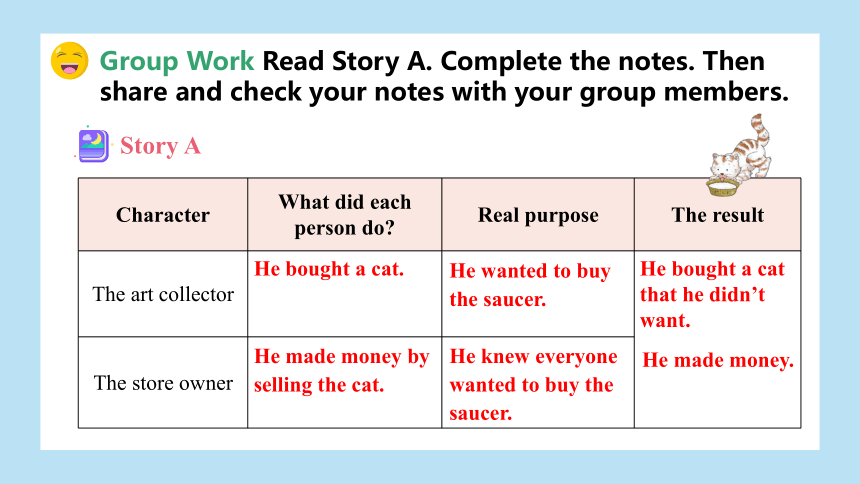
文档简介
(共43张PPT)
Unit 4
Humour
Lesson 1 (Reading)
Learning Objectives
PART. 01
Understand the daily study and life of British middle school students by watching videos. Based on your own daily study and life, compare the study and life in Chinese and British schools, and find out the similarities and differences between the two. Talk about your first impression of high school life, and have a preliminary perception of the study and life in the senior high school stage.
Learning Objectives
Analyze humorous stories to understand plot elements (characters, settings, conflicts), extract details, and answer comprehension questions. Practice inferring humour and interpreting story structures. Through group work, retell stories, discuss humour elements, and explain why stories are funny.
Explore how humour reflects cultural values — e.g., wordplay in Story A, scientific deduction in Story B, and social-situational irony in Story C. Understand that humour styles vary across cultures and contexts, recognizing universal and cultural -specific comedic traits.
Break down stories into components (characters, actions, humorous parts), analyzing cause-effect relationships (e.g., antique saucer → cat’s value). Use evidence to explain why stories are funny, interpreting narrative structures and comedic devices.
Use “story analysis” strategies (extracting details, identifying humour elements) and “collaborative retelling” to refine communication. By independently analyzing stories, completing writing tasks, and reflecting on humour preferences, students take ownership of learning.
Understand the daily study and life of British middle school students by watching videos. Based on your own daily study and life, compare the study and life in Chinese and British schools, and find out the similarities and differences between the two. Talk about your first impression of high school life, and have a preliminary perception of the study and life in the senior high school stage.
Teaching Focuses and Anticipated Difficulties
Analyze humorous stories to understand plot elements, extract details, and discuss/retell them in group work.
Analyzing cause-effect in stories to explain why they are funny and understanding cultural variations in humour styles.
Lead-in
PART. 02
Have you read these humorous stories
Reading
PART. 03
Do you like reading humorous or funny stories Why
Example:
I like reading humorous stories because I like the play on words.
Look at the 3 pictures and predict what each story may be about.
Work in groups of three. Each student reads one of the stories and answers the following questions. Then share what you have read with your group members.
1. Which characters are in the story
a famous art collector, a store owner and a cat.
2. Where are they
They are in a store in the city.
Story A
Work in groups of three. Each student reads one of the stories and answers the following questions. Then share what you have read with your group members.
3. What happened to/ between them
The art collector wanted to buy the saucer but instead bought a cat.
4. Why is it funny
The store owner knew everyone wanted to buy the saucer the cat used, and he made money by selling the cat.
Story A
Group Work Read Story A. Complete the notes. Then share and check your notes with your group members.
Character What did each person do Real purpose The result
The art collector
The store owner He made money by selling the cat.
He bought a cat.
He wanted to buy the saucer.
He bought a cat that he didn’t want.
He knew everyone wanted to buy the saucer.
He made money.
Story A
Work in groups of three. Each student reads one of the stories and answers the following questions. Then share what you have read with your group members.
1. Which characters are in the story
Sherlock Holmes and Dr. Watson.
2. Where are they
They are outdoors.
3. What happened to/ between them
They were on a camping trip. They were talking about the stars that they could see.
Story B
Work in groups of three. Each student reads one of the stories and answers the following questions. Then share what you have read with your group members.
4. Why is it funny
Watson spoke about astronomy, the positions of stars, the scientific measurement of time and the atmosphere but didn’t realise they could see the stars because their tent had been stolen.
Story B
Group Work Read Story B. Complete the notes. Then share and check your notes with your group members.
Character What did each person do Real purpose The result
Sherlock Holmes
Dr. Watson He woke up and asked Watson what he saw.
Story B
He spoke about astronomy and the stars he saw.
He wanted Watson to confirm that their tent was stolen.
He focused on the stars.
He realized their tent was stolen.
He didn’t realise.
Work in groups of three. Each student reads one of the stories and answers the following questions. Then share what you have read with your group members.
1. Which characters are in the story
A doctor and a clown.
2. Where are they
They are in the doctor’s room.
Story C
Work in groups of three. Each student reads one of the stories and answers the following questions. Then share what you have read with your group members.
3. What happened to/ between them
The clown was feeling unhappy.
4. Why is it funny
The clown who makes everyone laugh can't cheer himself up.
Story C
Group Work Read Story B. Complete the notes. Then share and check your notes with your group members.
Character What did each person do Real purpose The result
The middle-aged man
The doctor Story C
He told the doctor that he was feeling down.
She asked the clown questions.
He wanted to see how he could feel better.
She wanted to figure out what was wrong.
The clown who makes everyone laugh can’t cheer himself up.
She suggested that he should go to see the clown who cheered everyone up.
Group Work Tell one of the three stories to your group based on your notes.
Complete the funny part of the three stories.
Story The funny part
A The store owner refused to give away the saucer with the cat because
___________________________________________________________
B Sherlock and Dr. Watson saw millions of stars at night because
___________________________________________________________
C An amazing clown couldn’t ___________________________________
___________________________________________________________
he has sold 68 cats because of the saucer.
their tent was stolen.
cheer himself up.
Complete the summaries with the words or phrases you have learnt from the stories.
An art collector noticed a cat lapping milk from a 1__________ in the 2___________ of a store. He realised that it was an 3___________ and very valuable. He decided to buy the cat and offered to pay 200 dollars in the end. Then he asked the store owner to 4___________ the saucer, but the owner refused to give it away for he had sold 68 cats because of this lucky saucer.
saucer
doorway
antique
throw in
Complete the summaries with the words or phrases you have learnt from the stories.
Sherlock Holmes asked his 5_________ friend Dr. Watson what he saw from the sky. "6___________________ of stars," said Dr. Watson. Based on his knowledge on 7___________, he believed there are millions of galaxies and 8___________ of planets. He deduced that it was probably a quarter past three based on the 9_______________________ of time. From the 10_____________________, he forecasted that it would be a beautiful day the next day. Watson didn't realise that someone had stolen their tent!
Millions and millions
faithful
astronomy
billions
scientific measurement
current atmosphere
Complete the summaries with the words or phrases you have learnt from the stories.
A middle-aged man who was 11___________________ went to the doctor. The doctor examined him and found 12______________ OK. The doctor thought that what the man needed was 13______________ and suggested 14___________________________. Actually he was 15___________.
feeling very down
everything
a good laugh
seeing a circus performing
the clown
Which of the three stories do you like most Why
Explore two methods of creating humour.
1. Play on words—pun (双关语)
An amusing use of a word or phrase that has two meanings, or of words that have the same sound but different meanings.
双关语指在一定的语言环境中,利用词的多义和同音的条件,有意使语句具有双重意义,言在此而意在彼的修辞方式。双关可使语言表达得含蓄、幽默,而且能加深语意,给人以深刻印象。双关可分为谐音双关和语义双关两类。
双关语最能发挥人的幽默和风趣。法国大文豪雨果也说:“双关语是飞舞着的灵魂的产物。”
Explore two methods of creating humour.
2. Sarcasm (讽刺)
Sarcasm generally takes the form of an ironic remark, somewhat rooted in humour, that is intended to mock or satirize something. When a speaker is being sarcastic, he is saying something different than what he actually means.
As a literary device, sarcasm can convey a writer and/or character's true feelings of frustration, anger, and even derision, though veiled by the presence of humour and wording that is inconsistent with what is intended. However, since sarcastic statements, as they are worded, contradict the speaker's intent and true meaning, it can be difficult for writers to effectively utilize this literary device without proper context or tone.
Explore two methods of creating humour.
讽刺是一种文学手法,用于暴露对象的缺点和可笑之处,常采用夸张或反讽等方式,从而产生幽默的效果。有时用讥刺和嘲讽笔法描写敌对的、落后的事物,有时用夸张的手法加以暴露,以达到贬低的效果。这就是说作者在真实的基础上,以讽刺和嘲讽的手法,揭露某些现象,批判某种行为,使人在会心的笑声中予以否定,这种手法就是讽刺。
讽刺手法犀利有力,而且使用灵活,或正面进攻,或旁敲侧击,或讽刺揶揄,或正颜厉色,嬉笑怒骂,皆成文章。归纳起来,讽刺手法大致有以下几种:
Explore two methods of creating humour.
(1)漫画法
漫画式的讽刺手法其特点是夸张,把人或事的假、丑、恶加以扩大或缩小,使之变相、变形,以突出这一侧面的特征,达到讽刺的目的。马克·吐温的《竞选州长》采用了这种手法,揭露不同社会的光怪陆离现象,在刻画人物形象方面起了重要作用。
Explore two methods of creating humour.
(2)对比法
即把被讽刺的对象,在对待同一人或事的前后不同的言行进行描述,以显示被讽刺对象的愚蠢可笑。莫泊桑的《我的叔叔于勒》围绕于勒有无金钱,描写菲力普夫妇言行、态度,前后判若两人的变化,使读者不难看出夫妇二人的极度虚伪、冷酷无情,进一步揭示了资本主义社会人与人之间赤裸裸的金钱关系。契诃夫的《变色龙》通过描写警官奥楚蔑洛夫围绕狗的主人是谁的易变、善变,无情地揭露了沙皇统治下社会的黑暗。
Explore two methods of creating humour.
(3)托物法
这是一种把讽刺对象比作某物,使讽刺对象具体化、形象化的手法。《惠子相梁》中的惠子听信传言,以为庄子来代他为相,非常恐惧。而庄子却给他讲了一个风趣的故事,他在故事中把自己比作鹓鶵(古代传说中像凤凰一样的鸟),惠子比作猫头鹰,梁国则比作腐鼠。他极力描写了鹓鶵高尚的志趣,而猫头鹰得一腐鼠便视为珍贵美味,讽刺之意溢于言表。这种技法在诸子百家著作及《战国策》中屡有所见。
Explore two methods of creating humour.
(4)反说法
反说法也就是“说反话”。作为讽刺手段的“反话”,是指用肯定、赞美的语言描述明显的丑恶、虚假的现象,表达作者的鄙视与挖苦。《藤野先生》开头一段对“清国留学生”的描写,表达的正是厌恶之极的情感。“实在标致极了”其实是指一点也不标致,称他们标致,是明显的讽刺。当任何指斥的言辞都不足以把愤怒之情表达的酣畅淋漓时,化为反语的讽刺,较之直言指责更为有力,表达的厌恶之情更为强烈。
Vocabulary
1. faithful
be faithful to sb 对某人忠诚
faithfully adv. 忠实地;忠诚地
faith n. 信念;信仰;信心
have/lose faith in... 对……有/失去信心
keep/break faith with sb 对某人守/不守信用
例题:
Even after years of marriage, they remain _________(faith) to each other, choosing to communicate openly instead of hiding secrets.
faithful
Vocabulary
2. measurement
measure v. 测量 n. 措施,方法
measure... by 用……来衡量
be measured in 以……方式测量/ 衡量
take measures/ steps/ action to do sth. 采取措施做某事
make sth. to sb’s measure 照某人的尺寸做某物
例题:
While some people think happiness is measured ______ wealth, others believe it lies in relationships and personal fulfillment.
in
Vocabulary
3. scream
scream (out) (in/with sth.) (因伤痛、害怕和激动等) 尖叫
scream (sth.) (out) (at sb.) (向某人)高声喊/ 大声叫
scream (out) (for sb./ sth.) (为某人/ 某事)高声喊/ 大声叫
例题:
She screamed ______ pain when she accidentally touched the hot stove, clutching her burned hand and gasping for breath.
in
Vocabulary
4. announce
announce +that从句 宣告……
It is announced+ that从句 据宣布……
announcement n. 宣告
announcer n. 播音员
例题:
The school made an _____________(announce) over the loudspeaker, informing students that classes would be canceled due to the heavy snowstorm.
announcement
Vocabulary
5. deserve
deserving adj. 值得的;应得的
deserve to do sth 应该做某事;值得做某事
deserve to be done = deserve doing sth. 值得被做
例题:
The volunteer spends every weekend helping the elderly, so she deserves ____________ (praised) for her kindness and dedication.
to be praised
Exercise
PART. 04
1. Her grandmother left her an a________(古董) necklace, said to have been worn by their ancestor at a royal wedding in the 1900s.
2. Silence filled the room, creating a tense a___________(气氛) as everyone waited for the teacher to announce the exam results.
3. Experts f________(预测) a rise in housing prices next year, based on growing demand and limited supply in major cities.
4. The museum’s new exhibition on a___________(天文学) includes interactive models of the solar system and a film about black holes.
ntique
Exercise: 单词拼写
tmosphere
orecast
stronomy
1. The teacher said the purpose of this composition ____________(examine) is to test whether we can express our opinions clearly.
2. The government launched a public _____________(consult), asking citizens to share opinions on the new environmental policy through online surveys.
3. While traditional beliefs can offer comfort, ___________(science) evidence provides a more accurate understanding of how the universe works.
4. The little girl ___________(innocent) picked the flower from the garden, not realizing it was her neighbor’s favorite rose.
examination
Exercise: 用所给词的适当形式填空
consultation
scientific
innocently
Summary
PART. 05
添加标题
ADD THE TITLE HERE
Lesson 1 (Reading)
Vocabulary
Analyze humorous stories to understand plot elements (characters, settings, conflicts), extract details, and answer comprehension questions.
Retell stories, discuss humour elements, and explain why stories are funny.
Reading
faithful, measurement, scream, announce, deserve
Homework
PART. 06
Prepare a humorous or funny story for next class’s share.
Homework
Unit 4
Humour
Lesson 1 (Reading)
Learning Objectives
PART. 01
Understand the daily study and life of British middle school students by watching videos. Based on your own daily study and life, compare the study and life in Chinese and British schools, and find out the similarities and differences between the two. Talk about your first impression of high school life, and have a preliminary perception of the study and life in the senior high school stage.
Learning Objectives
Analyze humorous stories to understand plot elements (characters, settings, conflicts), extract details, and answer comprehension questions. Practice inferring humour and interpreting story structures. Through group work, retell stories, discuss humour elements, and explain why stories are funny.
Explore how humour reflects cultural values — e.g., wordplay in Story A, scientific deduction in Story B, and social-situational irony in Story C. Understand that humour styles vary across cultures and contexts, recognizing universal and cultural -specific comedic traits.
Break down stories into components (characters, actions, humorous parts), analyzing cause-effect relationships (e.g., antique saucer → cat’s value). Use evidence to explain why stories are funny, interpreting narrative structures and comedic devices.
Use “story analysis” strategies (extracting details, identifying humour elements) and “collaborative retelling” to refine communication. By independently analyzing stories, completing writing tasks, and reflecting on humour preferences, students take ownership of learning.
Understand the daily study and life of British middle school students by watching videos. Based on your own daily study and life, compare the study and life in Chinese and British schools, and find out the similarities and differences between the two. Talk about your first impression of high school life, and have a preliminary perception of the study and life in the senior high school stage.
Teaching Focuses and Anticipated Difficulties
Analyze humorous stories to understand plot elements, extract details, and discuss/retell them in group work.
Analyzing cause-effect in stories to explain why they are funny and understanding cultural variations in humour styles.
Lead-in
PART. 02
Have you read these humorous stories
Reading
PART. 03
Do you like reading humorous or funny stories Why
Example:
I like reading humorous stories because I like the play on words.
Look at the 3 pictures and predict what each story may be about.
Work in groups of three. Each student reads one of the stories and answers the following questions. Then share what you have read with your group members.
1. Which characters are in the story
a famous art collector, a store owner and a cat.
2. Where are they
They are in a store in the city.
Story A
Work in groups of three. Each student reads one of the stories and answers the following questions. Then share what you have read with your group members.
3. What happened to/ between them
The art collector wanted to buy the saucer but instead bought a cat.
4. Why is it funny
The store owner knew everyone wanted to buy the saucer the cat used, and he made money by selling the cat.
Story A
Group Work Read Story A. Complete the notes. Then share and check your notes with your group members.
Character What did each person do Real purpose The result
The art collector
The store owner He made money by selling the cat.
He bought a cat.
He wanted to buy the saucer.
He bought a cat that he didn’t want.
He knew everyone wanted to buy the saucer.
He made money.
Story A
Work in groups of three. Each student reads one of the stories and answers the following questions. Then share what you have read with your group members.
1. Which characters are in the story
Sherlock Holmes and Dr. Watson.
2. Where are they
They are outdoors.
3. What happened to/ between them
They were on a camping trip. They were talking about the stars that they could see.
Story B
Work in groups of three. Each student reads one of the stories and answers the following questions. Then share what you have read with your group members.
4. Why is it funny
Watson spoke about astronomy, the positions of stars, the scientific measurement of time and the atmosphere but didn’t realise they could see the stars because their tent had been stolen.
Story B
Group Work Read Story B. Complete the notes. Then share and check your notes with your group members.
Character What did each person do Real purpose The result
Sherlock Holmes
Dr. Watson He woke up and asked Watson what he saw.
Story B
He spoke about astronomy and the stars he saw.
He wanted Watson to confirm that their tent was stolen.
He focused on the stars.
He realized their tent was stolen.
He didn’t realise.
Work in groups of three. Each student reads one of the stories and answers the following questions. Then share what you have read with your group members.
1. Which characters are in the story
A doctor and a clown.
2. Where are they
They are in the doctor’s room.
Story C
Work in groups of three. Each student reads one of the stories and answers the following questions. Then share what you have read with your group members.
3. What happened to/ between them
The clown was feeling unhappy.
4. Why is it funny
The clown who makes everyone laugh can't cheer himself up.
Story C
Group Work Read Story B. Complete the notes. Then share and check your notes with your group members.
Character What did each person do Real purpose The result
The middle-aged man
The doctor Story C
He told the doctor that he was feeling down.
She asked the clown questions.
He wanted to see how he could feel better.
She wanted to figure out what was wrong.
The clown who makes everyone laugh can’t cheer himself up.
She suggested that he should go to see the clown who cheered everyone up.
Group Work Tell one of the three stories to your group based on your notes.
Complete the funny part of the three stories.
Story The funny part
A The store owner refused to give away the saucer with the cat because
___________________________________________________________
B Sherlock and Dr. Watson saw millions of stars at night because
___________________________________________________________
C An amazing clown couldn’t ___________________________________
___________________________________________________________
he has sold 68 cats because of the saucer.
their tent was stolen.
cheer himself up.
Complete the summaries with the words or phrases you have learnt from the stories.
An art collector noticed a cat lapping milk from a 1__________ in the 2___________ of a store. He realised that it was an 3___________ and very valuable. He decided to buy the cat and offered to pay 200 dollars in the end. Then he asked the store owner to 4___________ the saucer, but the owner refused to give it away for he had sold 68 cats because of this lucky saucer.
saucer
doorway
antique
throw in
Complete the summaries with the words or phrases you have learnt from the stories.
Sherlock Holmes asked his 5_________ friend Dr. Watson what he saw from the sky. "6___________________ of stars," said Dr. Watson. Based on his knowledge on 7___________, he believed there are millions of galaxies and 8___________ of planets. He deduced that it was probably a quarter past three based on the 9_______________________ of time. From the 10_____________________, he forecasted that it would be a beautiful day the next day. Watson didn't realise that someone had stolen their tent!
Millions and millions
faithful
astronomy
billions
scientific measurement
current atmosphere
Complete the summaries with the words or phrases you have learnt from the stories.
A middle-aged man who was 11___________________ went to the doctor. The doctor examined him and found 12______________ OK. The doctor thought that what the man needed was 13______________ and suggested 14___________________________. Actually he was 15___________.
feeling very down
everything
a good laugh
seeing a circus performing
the clown
Which of the three stories do you like most Why
Explore two methods of creating humour.
1. Play on words—pun (双关语)
An amusing use of a word or phrase that has two meanings, or of words that have the same sound but different meanings.
双关语指在一定的语言环境中,利用词的多义和同音的条件,有意使语句具有双重意义,言在此而意在彼的修辞方式。双关可使语言表达得含蓄、幽默,而且能加深语意,给人以深刻印象。双关可分为谐音双关和语义双关两类。
双关语最能发挥人的幽默和风趣。法国大文豪雨果也说:“双关语是飞舞着的灵魂的产物。”
Explore two methods of creating humour.
2. Sarcasm (讽刺)
Sarcasm generally takes the form of an ironic remark, somewhat rooted in humour, that is intended to mock or satirize something. When a speaker is being sarcastic, he is saying something different than what he actually means.
As a literary device, sarcasm can convey a writer and/or character's true feelings of frustration, anger, and even derision, though veiled by the presence of humour and wording that is inconsistent with what is intended. However, since sarcastic statements, as they are worded, contradict the speaker's intent and true meaning, it can be difficult for writers to effectively utilize this literary device without proper context or tone.
Explore two methods of creating humour.
讽刺是一种文学手法,用于暴露对象的缺点和可笑之处,常采用夸张或反讽等方式,从而产生幽默的效果。有时用讥刺和嘲讽笔法描写敌对的、落后的事物,有时用夸张的手法加以暴露,以达到贬低的效果。这就是说作者在真实的基础上,以讽刺和嘲讽的手法,揭露某些现象,批判某种行为,使人在会心的笑声中予以否定,这种手法就是讽刺。
讽刺手法犀利有力,而且使用灵活,或正面进攻,或旁敲侧击,或讽刺揶揄,或正颜厉色,嬉笑怒骂,皆成文章。归纳起来,讽刺手法大致有以下几种:
Explore two methods of creating humour.
(1)漫画法
漫画式的讽刺手法其特点是夸张,把人或事的假、丑、恶加以扩大或缩小,使之变相、变形,以突出这一侧面的特征,达到讽刺的目的。马克·吐温的《竞选州长》采用了这种手法,揭露不同社会的光怪陆离现象,在刻画人物形象方面起了重要作用。
Explore two methods of creating humour.
(2)对比法
即把被讽刺的对象,在对待同一人或事的前后不同的言行进行描述,以显示被讽刺对象的愚蠢可笑。莫泊桑的《我的叔叔于勒》围绕于勒有无金钱,描写菲力普夫妇言行、态度,前后判若两人的变化,使读者不难看出夫妇二人的极度虚伪、冷酷无情,进一步揭示了资本主义社会人与人之间赤裸裸的金钱关系。契诃夫的《变色龙》通过描写警官奥楚蔑洛夫围绕狗的主人是谁的易变、善变,无情地揭露了沙皇统治下社会的黑暗。
Explore two methods of creating humour.
(3)托物法
这是一种把讽刺对象比作某物,使讽刺对象具体化、形象化的手法。《惠子相梁》中的惠子听信传言,以为庄子来代他为相,非常恐惧。而庄子却给他讲了一个风趣的故事,他在故事中把自己比作鹓鶵(古代传说中像凤凰一样的鸟),惠子比作猫头鹰,梁国则比作腐鼠。他极力描写了鹓鶵高尚的志趣,而猫头鹰得一腐鼠便视为珍贵美味,讽刺之意溢于言表。这种技法在诸子百家著作及《战国策》中屡有所见。
Explore two methods of creating humour.
(4)反说法
反说法也就是“说反话”。作为讽刺手段的“反话”,是指用肯定、赞美的语言描述明显的丑恶、虚假的现象,表达作者的鄙视与挖苦。《藤野先生》开头一段对“清国留学生”的描写,表达的正是厌恶之极的情感。“实在标致极了”其实是指一点也不标致,称他们标致,是明显的讽刺。当任何指斥的言辞都不足以把愤怒之情表达的酣畅淋漓时,化为反语的讽刺,较之直言指责更为有力,表达的厌恶之情更为强烈。
Vocabulary
1. faithful
be faithful to sb 对某人忠诚
faithfully adv. 忠实地;忠诚地
faith n. 信念;信仰;信心
have/lose faith in... 对……有/失去信心
keep/break faith with sb 对某人守/不守信用
例题:
Even after years of marriage, they remain _________(faith) to each other, choosing to communicate openly instead of hiding secrets.
faithful
Vocabulary
2. measurement
measure v. 测量 n. 措施,方法
measure... by 用……来衡量
be measured in 以……方式测量/ 衡量
take measures/ steps/ action to do sth. 采取措施做某事
make sth. to sb’s measure 照某人的尺寸做某物
例题:
While some people think happiness is measured ______ wealth, others believe it lies in relationships and personal fulfillment.
in
Vocabulary
3. scream
scream (out) (in/with sth.) (因伤痛、害怕和激动等) 尖叫
scream (sth.) (out) (at sb.) (向某人)高声喊/ 大声叫
scream (out) (for sb./ sth.) (为某人/ 某事)高声喊/ 大声叫
例题:
She screamed ______ pain when she accidentally touched the hot stove, clutching her burned hand and gasping for breath.
in
Vocabulary
4. announce
announce +that从句 宣告……
It is announced+ that从句 据宣布……
announcement n. 宣告
announcer n. 播音员
例题:
The school made an _____________(announce) over the loudspeaker, informing students that classes would be canceled due to the heavy snowstorm.
announcement
Vocabulary
5. deserve
deserving adj. 值得的;应得的
deserve to do sth 应该做某事;值得做某事
deserve to be done = deserve doing sth. 值得被做
例题:
The volunteer spends every weekend helping the elderly, so she deserves ____________ (praised) for her kindness and dedication.
to be praised
Exercise
PART. 04
1. Her grandmother left her an a________(古董) necklace, said to have been worn by their ancestor at a royal wedding in the 1900s.
2. Silence filled the room, creating a tense a___________(气氛) as everyone waited for the teacher to announce the exam results.
3. Experts f________(预测) a rise in housing prices next year, based on growing demand and limited supply in major cities.
4. The museum’s new exhibition on a___________(天文学) includes interactive models of the solar system and a film about black holes.
ntique
Exercise: 单词拼写
tmosphere
orecast
stronomy
1. The teacher said the purpose of this composition ____________(examine) is to test whether we can express our opinions clearly.
2. The government launched a public _____________(consult), asking citizens to share opinions on the new environmental policy through online surveys.
3. While traditional beliefs can offer comfort, ___________(science) evidence provides a more accurate understanding of how the universe works.
4. The little girl ___________(innocent) picked the flower from the garden, not realizing it was her neighbor’s favorite rose.
examination
Exercise: 用所给词的适当形式填空
consultation
scientific
innocently
Summary
PART. 05
添加标题
ADD THE TITLE HERE
Lesson 1 (Reading)
Vocabulary
Analyze humorous stories to understand plot elements (characters, settings, conflicts), extract details, and answer comprehension questions.
Retell stories, discuss humour elements, and explain why stories are funny.
Reading
faithful, measurement, scream, announce, deserve
Homework
PART. 06
Prepare a humorous or funny story for next class’s share.
Homework
同课章节目录
- Unit 4 Humour
- Lesson 1 What’s So Funny?
- Lesson 2 Why Do We Need Humour?
- Lesson 3 My Favourite Comedian
- Unit 5 Education
- Lesson 1 Enlightening a Mind
- Lesson 2 The Objectives of Education
- Lesson 3 Understanding
- Unit 6 The Media
- Lesson 1 From Page to Screen
- Lesson 2 Questions about Media
- Lesson 3 The Advertising Game
